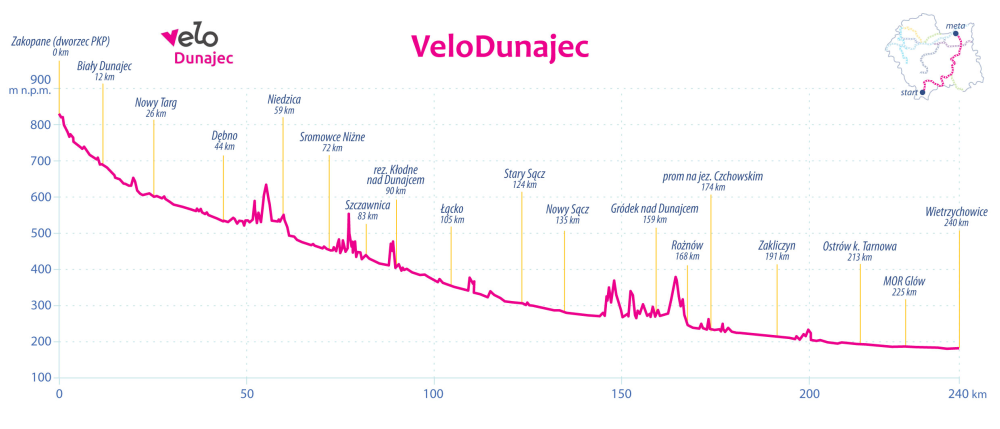Lenght – 237 km (partially connected with EuroVelo11/VeloNatura)
Current VeloDunajec maps in PDF, edition 2024, available for download and printing (A4 format).
1.Podhale / 2. Lake Czorsztyn / 3. Beskid Sądecki / 4. Lake Rożnów and Nowy Sącz / 5. Rożnów Foothills / 6. Tarnów and The Surrounding area / 7. North-East Małopolska / 8. Ujście Jezuickie – Szczucin
VeloDunajec is an extremely varied cycling route. It leads through picturesque areas between mountain ranges from the Tatra Mountains through the Gubałówka Foothills, Gorce, Spisz, Pieniny, Beskid Sądecki, Beskid Wyspowy and Rożnowskie Foothills to the completely flat area of Tarnów and the confluence of the Dunajec with the Vistula. Although the route is not yet complete in some sections, it is worth riding the entire route from Zakopane to Wietrzychowice.
Proposed route of the Małopolska section including detours / download GPX file
Please note! The route is not yet fully completed.
All obstructions are systematically indicated on the map below.
We start at the railway station in Zakopane. This is a very good logistical starting point in the centre. We head north towards Poronin, passing Biały Dunajec, Szaflary and behind our backs we can often see the majestic panorama of the Tatra Mountains. In this section, most of the route leads along side roads in the general traffic, but already in Nowy Targ we enter a comfortable asphalt road for bicycles separated from the car traffic. At the point where the Biały Dunajec stream flows into the Dunajec River, the route's surroundings take on a much more natural atmosphere and, with a sharp turn to the east, its character changes from urban to idyllic and typically rural. Crossing the bridge over the Dunajec River in Ostrowsko, you will find yourself in the Gorce Mountains, only to return to its right bank a few kilometres later and find yourself in the Spisz region. Almost next to the route, in Dębno Podhalański, we have an opportunity to visit the historic wooden church of St. Michael the Archangel inscribed on the UNESCO World Heritage List. It is a real pearl among the monuments of Małopolska on the Wooden Architecture Route, so visiting conditions are strictly determined by the local Parish. Before entering the crown of the ramparts, the VeloDunajec route joins the local route around Lake Czorsztyńskie. It is worth taking a ride along the northern shore, often leading almost over the surface of the water, all the way to Czorsztyn.
There, for those willing, it is possible to cross the lake by boat or gondola, which run between the castles in Czorsztyn and Niedzica. The VeloDunajec route is in principle manageable for any cyclist, but the section on the south side of the lake, especially the climb up to Falsztyn, has become legendary for its difficulty. Suffice it to say that the sight of cyclists leading their bikes uphill is not unusual here. After this demanding section, it is worth planning a longer rest in Niedzica, which offers two unique attractions: for lovers of history and legends - the medieval castle, and for amateurs of hydro-technical structures - Poland's highest earth dam with a power station. After descending from the dam's crest, we drive on the Polish side of the Dunajec River as far as Sromowce Niżne. On the way, we pass the starting points of traditional rafting trips, pontoons and canoes. Here is a valuable note: if you decide to go rafting, you can take your bike with you, but definitely the Dunajec Gorge (from Sromowce Niżne to Szczawnica) is worth crossing on two wheels. In Sromowce Niżne, we cross the Dunajec river by the famous footbridge, which is also the Polish-Slovak border. We pass the ruins of the Red Monastery and enter a 9 km gravel section of the route. We are in the Pieniny National Park and above us stretch the vertical walls of the Pieniny Mountains, several hundred metres high, with the Three Crowns and Sokolica. In Szczawnica, we return again to the hard asphalts of the walking and cycling trails, up to the new cycle bridge in Krościenko nad Dunajcem. In the section between Krościenko and Zabrze, we will encounter a several-kilometre discontinuity of the route, so here we have to reckon with the necessity to ride on the voivodeship road, with intense car traffic.
Completion of further elements of cycling infrastructure along DW969, is planned by 2023. The route is led once along the left bank of the Dunajec River - here we are in the Gorce Mountains or Beskid Wyspowy, and once along the right bank - where we are in turn in the Beskid Sądecki. If our trip falls in April or early May, we will be greeted by fabulously colourful fruit orchards in the vicinity of Zabrzeże and Łącko. After all, this is the capital of blossoming orchards, from which come certified traditional products such as "Śliwowica Łącka" and "Jabłka łąckie".
In Stary Sącz, near the confluence of the Poprad River with the Dunajec River, we reach the connection with another cycling route of the VeloMalopolska network, i.e. the VeloNatura route (EuroVelo11). From this point until Ostrów both routes share the same route. Currently, the VeloDunajec/VeloNatura route marking ends in Wieloglowy. In order to pass the section to Czchów efficiently, it is worth using the proposal of a diversion along ordinary roads and attention! with solid elevation.
From Czchów through Zakliczyn to the north, the route runs partly on floodbanks and partly on roads through small towns. For less experienced cyclists, we recommend taking the entire section by train from Nowy Sącz to the railway station in Bogumiłowice. The area around this small railway station, i.e. Ostrów and Wierzchosławice, is an important junction of routes where VeloDunajec and VeloNatura intersect with the VeloMetropolis route (EuroVelo 4). VeloNatura turns west and connects with VeloMetropolis. The VeloDunajec, on the other hand, runs independently to the north until it connects with the Vistula Cycle Route in Wietrzychowice. Along the way, you will pass, among others, Radłów with its distinctive monument commemorating the Battle of the Dunajec Bridge in 1939 and war cemeteries. The route is led almost all the time comfortably and safely along flood embankments.
Elevation profile of the route:

